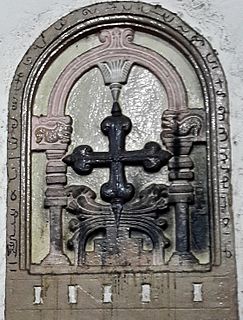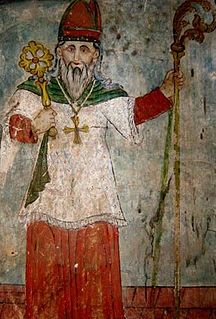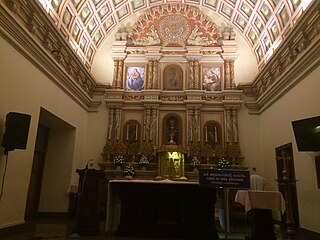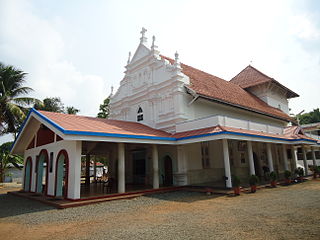
The Malankara Orthodox Syrian Church (MOSC) also known as the Malankara Church and the Indian Orthodox Church, is an autocephalous (independent) church based in Kerala, India. Part of Oriental Orthodoxy, it is one of the oldest Christian communities in Asia. The church serves India's Saint Thomas Christian population. According to tradition, the church originated during the first-century AD missions of Thomas the Apostle. The autocephalous Catholicos of the East and the Malankara Metropolitan, enthroned on the Apostolic Throne of St. Thomas, is the primate of the church. It employs the Malankara Rite, an Indian form of the West Syriac liturgical rite.

The Saint Thomas Christians, also called Syrian Christians of India, Nasrani or Malankara Nasrani or Nasrani Mappila, are an ethnoreligious community of Indian (Malayali) Syriac Christians from Kerala, India, who trace their origins to the evangelistic activity of Thomas the Apostle in the 1st century. The terms Syrian or Syriac relate not to their ethnicity but to their historical, religious, and liturgical connection to Syriac Christianity. Nasrani is an Arabic term for "Christian" that emerges from the Greek word Nazōraioi translated in English to Nazarene, the Nazarenes were one of the earliest Christian communities of Jewish origin dating back to the 1st century AD.

The Syro-Malankara Catholic Church, also known as the Malankara Syrian Catholic Church, is an Eastern Catholic, autonomous, particular church, in full communion with the Pope and the worldwide Catholic Church, with self-governance under the Code of Canons of the Eastern Churches. It is part of the Major Archiepiscopal Churches of the Catholic Church that are not distinguished with a patriarchal title. It is headed by Major Archbishop Baselios Cardinal Cleemis Maphrian of the Major Archdiocese of Trivandrum based in Kerala, India.

The Syro-Malabar Catholic Church or Church of Malabar Syrian Catholics is an Eastern Catholic Major Archiepiscopal Church based in Kerala, India. It is an autonomous particular church in full communion with the Pope and the worldwide Catholic Church, with self-governance under the Code of Canons of the Eastern Churches. The Church is headed by the Metropolitan and Gate of all India Major Archbishop George Cardinal Alencherry. The name Syro-Malabar is a prefix coined from the words Syriac as the church employs the East Syriac Rite liturgy, and Malabar which is the historical name for modern Kerala. The name has been in usage in official Vatican documents since the nineteenth century.

The Synod of Diamper, held at Udayamperoor, known as Diamper in non-vernacular sources, was a diocesan synod, or council, that created rules and regulations for the ancient Saint Thomas Christians of the Malabar Coast, modern Kerala state, India, formally uniting them with the Catholic Church. This led to the creation of the Eastern Catholic Syro-Malabar Church, which follows East Syriac Rite liturgy.

Archbishop Aleixo de Menezes or Alexeu de Jesu de Meneses was Catholic Archbishop of Goa, Archbishop of Braga, Portugal, and Viceroy of Portugal during the Philippine Dynasty.

The Coonan Cross Oath, taken on 3 January 1653, was a public avowal by members of the Saint Thomas Christians community of modern-day Kerala, India that they would not submit to Roman Pope and Latin Catholic Portuguese Padroado dominance in ecclesiastical and secular life.

The Chaldean Syrian Church of India is an Eastern Christian Church based in Thrissur, India. It is an archbishopric of the Holy Apostolic Catholic Assyrian Church of the East and is in full communion with Catholicos-Patriarch Mar Gewargis III.

Mor Thoma I, also known as "Valiya Mar Thoma", is the first native democratically elected/selected Metropolitan bishop of the St Thomas Christians or Malankara Church. He was the last Archdeacon of the undivided St. Thomas Christians of Malabar. After the death of Archdeacon George of the Cross on 25 July 1640, Parambil Thoma Kathanar was elected and enthroned as new Archdeacon, when he was less than 30 years old. He led the Church to the Coonan Cross Oath on 3 January 1653 and to the subsequent schism in Saint Thomas Christians Church. After the Coonen Cross Oath, he was elected as a Bishop by Malankara (Yogam) Association and consecrated as a Bishop at St. Mary's Church Alangad, by laying hands of 12 priests on 22 May 1653. Only two Southist churches of Kaduthuruthy and Udayamperoor and a very few people elsewhere refused to recognise him as Bishop. Any how, the archdeacon began to exercise powers of episcopal order, though he openly tried to regularize his episcopal consecration as a Bishop from the Church of Antioch. His episcopal consecration as a Bishop was regularized in the year 1665 by Mar Gregorios Abdal Jaleel the Patriarchal delegate of the Syriac Orthodox Patriarch of Antioch.(The exact date and place of this event is anonymous).

This is a timeline of the history of the Syro-Malabar Catholic Church in India.

The Malankara Church is an Apostolic Church came in to exist as a result of the evangelical activities of St Thomas, one of the Apostle of Lord Jesus Christ in AD 52. The word 'Malankara' is the combine of two words 'Mala' which means mountains and 'Kara' which means Land Surface. Malankara is the Land of confluence of Mountain and Land Surface. This land had an historical trade connection with middle east countries from ancient era and the traders from Egypt ,Persia etc. are frequently visited this land for getting Spices. These groups were included Arabs,Jews and also Christians and the christians who visited here was maintained a contact with the Malankara Church. They were Coptic and Pesian Christians and thus the Church in Malankara was well in touch with other Eastern Churches such as Coptic and Persian Churches. The Malankara Church is headed by 'Malankara Moopan' who is the Successor of St Thomas the Apostle and also the heir of the Apostolic Throne of St Thomas in Malankara. The Malankara Church was unique and unanimous till the 16th century and later some rifts are happened due to the Colonisation of the western portuguese missionaries. A group of people were left the church in 1663 by follow Parambil Chandi Kathanar who joined Roman Catholic church and the first split in Malankara Church and this split caused to the emergence of the first Uiate Rite in Malankra.The People who stood with Malankara Moopan remained as Malankara Nasranis
Christianity is the third-most practised religion in Kerala, accounting for 18% of the population according to the Indian census. Although a minority, the christian population of Kerala is proportionally much larger than that of India as a whole. A significant portion of the Indian Christian population resides in the state.

Muttuchira is a village in Kottayam district in the state of Kerala, India.

Mar Podipara Ouseph Placid Malpan also known as Vishuda Placidachan was an Indian Catholic priest and scholar of the St. Thomas Christian community. He was a scholar in East Syriac language and liturgy. A book published on the tenth anniversary of his death calls him one of the greatest ecclesiastical luminaries of the 20th century in India. He was a member of the Syro Malabar Church and was ordained a priest from the Eastern Catholic religious institute of the Carmelites of Mary Immaculate (C.M.I.). He was also a theologian, liturgist, orator, professor, ecumenist, and author.

The Malankara Rite is the form of the West Syriac liturgical rite practiced by several churches of the Saint Thomas Christian community in Kerala, India. West Syriac liturgy was brought to India by the Syriac Orthodox Bishop of Jerusalem, Gregorios Abdal Jaleel, in 1665; in the following decades the Malankara Rite emerged as the liturgy of the Malankara Church, one of the two churches that evolved from the split in the Saint Thomas Christian community in the 17th century. Today it is practiced by the various churches that descend from the Malankara Church, namely the Malankara Orthodox Syrian Church, the Jacobite Syrian Christian Church, the Syro-Malankara Catholic Church, the Malabar Independent Syrian Church, and the Mar Thoma Syrian Church.

The Saint Thomas Christian denominations are traditional Christian denominations from Kerala, India, who trace their origins to the evangelistic activity of Thomas the Apostle in the 1st century. They are also known as "Nasranis" as well. The Syriac term "Nasrani" is still used by St. Thomas Christians in Kerala.

Several historical evidences shed light on a significant Malankara–Persia relationship that spanned centuries. While a fraternal relationship existed between Malankara and Persia in the earlier centuries, closer ecclesiastical ties developed as early as 15th century and endured until the Portuguese colonial invasion of Malabar in 16th century. The Christians who came under the two ancient yet distinct lineages of Malankara (India) and Persia had one factor in common: their Saint Thomas heritage. The Church of the East shared communion with the Great Church until the Council of Ephesus in the 5th century, separating primarily over differences in Christology.

Mar Hormizd Syro-Malabar Catholic Church, Angamaly is a church located in Angamaly, Kerala, India. It was established in 1570 by Mar Abraham, the last Chaldean Metropolitan to reach Malabar Coast. It is dedicated to Mar Hormizd, a seventh-century Chaldean saint.

St Mary's Jacobite Syrian Church, Angamaly is believed to be built in AD 409 and is the first church built in Angamaly. It is an ancient church and one of the most prominent churches in Kerala. It was the seat of the Archdeacon, the local head of the Malankara Church and hence held an important position in Malankara for many centuries.
















